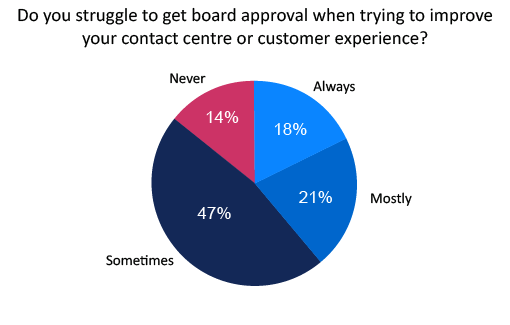22nd June 2016

In this next part of our Contact Centre Manifesto series, we take an in-depth look at how to create a business case by highlighting the real cost of bad customer service.
Contact centre professionals have often struggled to speak the language of the boardroom and be granted the budget they need to run a successful and adaptable operation.
This notion was supported in a 2016 Call Centre Helper survey, which found that 18% of industry professionals “always” struggle to get board approval, and a further 21% “mostly” struggle.

In a separate survey which ran in 2015, budget, IT issues, the need for new technology, technology not being joined up, conflicting business priorities and management buy-in were all listed as the top barriers to running a dream contact centre.
To tackle this problem at its root cause, every contact centre manager should learn the key skills needed to deliver a compelling business case in the boardroom – and secure the budget they need to improve their operation.
Even those who aren’t working in a sales environment – and don’t have to worry about competitors – can benefit from making their operation more efficient and effective.
“Compelling events can give a business case a solid foundation to work with, as the board will likely be aware of these issues and will already be seeking solutions,” said Simon Foot, Group Development Director at Ember Services. “Examples of compelling events include moving to new premises, upgrading to the cloud and meeting the increasing demands of modern customers.”
It can also help to align your business case with the key trends developing in the industry.
Here are some that are already in motion in the contact centre industry:

If business is running as normal, it can be a lot harder to justify investment.
However, there are a number of measurements to choose from that can help you get the attention of the board:
You could also support your business case by presenting “cost to deploy” vs “cost savings” – alongside revenue generation.
“It can also help if you can add in real facts and figures from a department or organisation which has recently completed the same (or similar) upgrade,” said Simon Foot, Group Development Director at Ember Services. “If you are looking to implement a new technology, it can help to ask your chosen provider for case-study findings and statistics from some of their other clients.”
Key areas to focus on include the positive impact on capital costs, internal resources, demand on IT and support for home agents.
It can also help your business case if you are able to quote your customer’s lifetime value in relation to the problem.
Here is a simplified example:
If you know that every customer spends roughly £5,000 during the course of their relationship with you – and your current issue (e.g. failed deliveries) is costing you 11 customers per week – you can suggest that the problem is losing the business £55,000 (11 multiplied by £5,000) of future revenue every week. £660,000 per quarter!
That suddenly becomes a rather sizeable number – especially if you include a projection figure of how much the company will have lost if the problem is still unfixed in 3 months’ time.
These calculations can also help support the benefits of reducing churn rates. For example, if you can reduce churn by 5%, you are saving the company [Customer Lifetime Value multiplied by 5% of your customer base].
Click to find out how to calculate Customer Lifetime Value
If you are trying to secure funding for an IVR that validates a customer’s account details before putting them through to an agent, you may be tempted just to say “this IVR will save our agents 30 seconds on every call”.
While one or two members of the board might do the maths, the chances are this statistic will just get lost in the mix.
Instead, do the maths beforehand and present this figure to the board.
This could be as simple as taking that same 30-second saving on every call (provided by the new IVR investment) and combining that with the fact that an agent takes 200 calls per day and you have a team of 70 agents.
That’s (30 seconds X 200 calls) X 70 agents = 420,000 seconds saved… A saving of over 100 hours of talk time and a reduction of 12 agents needed to tackle the same call volume every day.
When you then add in what those 12 agents cost your organisation in terms of their £18,000 per annum salary (for example) plus training and benefits, the figure very quickly spirals to a saving upwards of £200,000 per year – a number that isn’t easy to ignore!

While Return on Investment (ROI) and reduced cost savings are a great starting point for delivering a compelling business case, it can also support your case to look at the wider benefits of your proposed investment.
The following non-financial criteria should also be considered in developing the strategic rationale – a minimum of two should be included in each business case:

No matter how many people are involved in the decision-making process, it will always be the executives that step in and outweigh everyone in the final decision.
You need to prepare for this if you want your business case to be successful.
It is important that you tailor your business case in line with the priorities of the company executives. For example, cost savings and strategy.
You will also need to elevate your business case to align with the strategic intent of the business.
For example, explain how this will help you sell more of your product and become a market leader, or how offering social media will bring you in line with your competitors.
It can also be very effective to outline the business risks associated with leaving things as they are, a “push factor” to prompt change.
Consider leading these risks with “If we don’t do this, we won’t be able to…”
Don’t leave it to the last minute to get input from the finance team.
The finance team can add value in key tasks such as researching historical trends, developing expense forecasts, and ensuring proper calculation of Net Present Value (NPV), Internal Rate of Return (IRR) and Payback Period.
Project managers or members of finance can also help you to shape your approach so you are able to get what you need, as they generally do a lot of work for the leadership team.
They should also be able to help you to plan around the financial cycles of the business, so you can set your business case into the corporate business plan and ensure budget is set aside for the following year’s improvements.
It is also important to work out exactly how much money you are asking for and the manpower that will be required to bring the project to fruition.
Here are some key questions to discuss with your team:
If you haven’t thought this through properly, you may get caught out in the boardroom, or your project could fail later on – jeopardising your chances of securing more budget in the future.
Talking to key board members in advance can help you to get some level of buy-in before you make your formal presentation.
It can also help to approach these people individually to discuss the merits of what you plan to propose, as one person is a lot easier to convince then several.
Your audience will already be warmed up and on board before you formally pitch your idea, improving the chances of success.
It’s also a good idea to show these key board members that you have spoken through your presentation in advance of the meeting, asking for feedback, or any changes they would like to make.

Once you have pulled all the facts together and are confident you have a strong business case, you will need to put a presentation together.
This is not the time to be blasé. The delivery of the information will have just as much impact as the information itself.
Here are some key points to keep in mind when pitching your idea to the board:
After successfully securing the budget you need, your first reaction will likely be to take the money and run… Before the board have a chance to change their mind!
However, as technology and customers are constantly changing, it won’t be the last time you need to ask for money.
After rolling out the new project you’ve secured budget for, a post-implementation review should be completed on all initiatives:
If you build up credibility for delivering on what you said you would, you will have a much easier time putting your case forward in future.
With thanks to:
